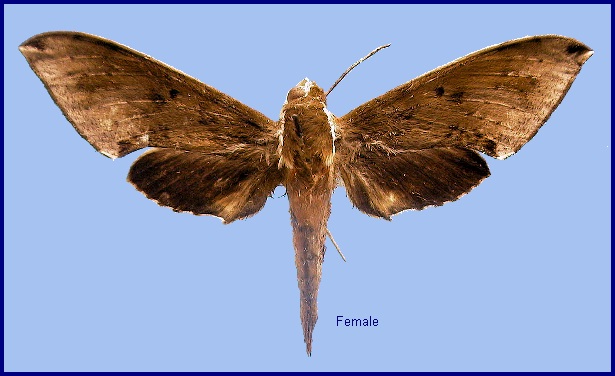
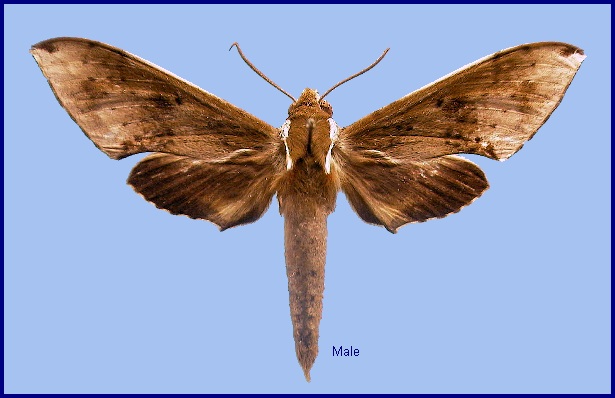
Rhagastis albomarginatus dichroae Mell, 1922, Dt. ent. Z. 1922: 120. Type locality: China, Kuangtung [Guangdong].
Synonym. Rhagastis mongoliana centrosinaria Chu & Wang, 1980.
Almost identical to Rhagastis binoculata, distinguishable only in the greyish-buff (rather than pinkish-grey) oval patch across the postmedian lines on the forewing upperside. Smaller than Rhagastis albomarginatus, tending towards dark green, with a conspicuous and discrete pale oval patch on forewing upperside between M2 and Cu2 dividing the postmedian lines, and within which the third postmedian line is represented by a conspicuous pair of vein dots. There is a similar but less marked pale area between the antemedian and postmedian lines below the discal cell, and subapically between Rs3 and M1 distal to the postmedian lines. The forewing is also narrower than that of R. albomarginatus; underside colour tends to be orange-yellow. Black solid circle on hindwing underside faded but still can be recognized (Jiang et al., 2024).
The male genitalia are similar to those of R. albomarginatus, but the uncus and gnathos are shorter. Valva more rounded. Sacculus shorter and more curved than in R. albomarginatus. The phallus is straight, with the anterior lobe of the process ending in a slender transverse hook with fewer apical spinules (Jiang et al., 2024).
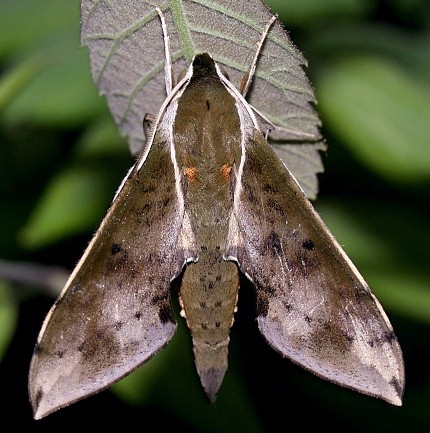
China: ii-xi (Guangdong); iii-x (Hong Kong); iii (Guangxi); iv (Guizhou); iv-viii (Zhejiang); vi (Beijing); viii (Sichuan).
Kendrick (2002) states that this common species may be quadrivoltine in Hong Kong during late March to early April, mid May to late June, late July to mid August, and in early October.
OVUM: Pale yellowish.
LARVA: Full-fed 100mm., width 15mm.; horn 8mm. According to Bell & Scott (1937), in Rhagastis albomarginatus the first instar is pale honey-yellow, with a short, straight, black horn; surface of body very smooth and shiny. In the second instar, head pale blue; body green, with a shiny and translucent appearance; segment five tumid; an eye-spot on segment five black edged with white; horn pale blue. By the third instar, body dotted with yellow; a dorso-lateral and a sub-spiracular stripe on segments 2 to 4, and oblique stripes on 6 to 11 pale blue; an eye-spot on segment five, which is very tumid, pupil pale blue edged broadly with white and narrowly with black; this eye-spot shiny and conical; horn dark blue. In the fourth instar, with a dark blue dorsal stripe; horn down-curved, smooth and shiny, clubbed at the tip.
In the fifth and final instar, shape the same as others of the genus. Head dull and smooth. Body shiny as though enamelled, including the eye-spot and horn. The latter of medium length, thick at base, proximal half tapering sharply, then cylindrical to near the slightly bulbous tip, bent slightly downwards in the middle. In colour, head pale blue, body pale yellowish in dorsal area, lateral area pale grass-green or bluish-green with a number of short, longitudinal, dark green lines across the secondary rings, turning to bluish dots below the spiracles and on venter; a narrow, broken, dark green dorsal stripe from segment two to base of horn; a broad, pale blue or whitish dorso-lateral stripe on segments 2 to 4; a similar sub-spiracular stripe on 2 to 4, meeting at a sharp angle the lower end of the oblique stripe on segment 5; eye-spot on 5 round or obliquely oval, conical in shape, the small pupil, at the apex of the cone, deep blue; it is edged broadly with very pale blue, this again edged broadly with white, the whole edged narrowly with black; broad pale blue oblique stripes on segments 5 to 12, each running through the spiracle and forwards on to the segment in front and back on to the segment behind, that on 11 running across 12 to base of horn, that on 12 narrower than the rest and stopping just behind the spiracle. Horn dark blue with a series of darker blue, narrow rings from near base to tip; legs, prolegs, anal flap and claspers pale blue. Spiracles ochreous. There is no dark-coloured form, though some individuals are of a darker shade of green than others. When alarmed, the anterior segments are strongly retracted into segment five, which then becomes very swollen. The bright colouring, the shiny enamel-like surface and the protruding conical eye-spots, looking like a pair of staring eyes, give the larva a very striking appearance (Bell & Scott, 1937).
Bell & Scott (1937) state that in India the larvae of Rhagastis albomarginatus were very voracious feeders, and being extremely common at Shillong (Khasi Hills, Meghalaya), hydrangea bushes there were frequently stripped of all their leaves. One bush which was kept under observation was so stripped three times in one season, eggs were laid on the fresh shoots as soon as they appeared. Every season immense numbers of larvae were destroyed by gardeners, and by ants when, having stripped one bush, they were compelled to come to the ground to seek other food. In spite of this annual destruction, no diminution in the numbers of larvae was noticed during a period of ten years. They also appeared to be singularly immune from attacks by parasitic wasps and flies.
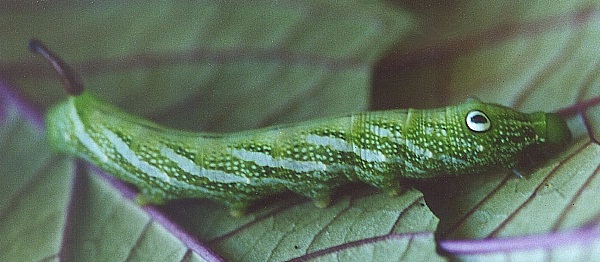
PUPA: 55mm., width 11mm.; cremaster 3mm. In Rhagastis albomarginatus, tongue-sheath more prominent ventrad than frontad. Surface dull and smooth except for rounded tubercles on veins of wing-case and legs. Cremaster triangular, ending in two shafts which are broad and coalescing at base, each shaft ending in a weak incurved spine and a longer, stronger, outcurved spine; there is a dorso-lateral spine near base of cremaster and another about half-way between base and tip, each ending in two minute hooks; upper surface of cremaster shagreened, lower surface deeply longitudinally grooved. Head, thorax and wing-case pale brown, darker on dorsum; the tubercles on legs and veins dark brown; abdomen ochreous with paler patches above and below the spiracles, which are dark brown; bevels of free abdominal segments reddish; shaft and spines of cremaster black (Bell & Scott, 1937).
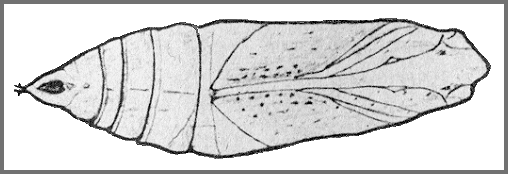

Larval hostplants. Vernicia montana (Euphorbiaceae) and Dichroa febrifuga (Hydrangeaceae; Li, pers. comm. 2002) in Hong Kong.
Unknown.
China: Beijing (Baihua Shan); Anhui (Dabieshan; Yuexi, 1020m); Zhejiang (Mogan Shan; Tianmu Shan, 763m); Hubei (Yingshan; Yichang, 1080m); Sichuan (Guan Xian); Chongqing (Simian Mountain National Scenic Resort); Guizhou (Jiucai Ling; Fanjingshan, Tongren; Leigongshan, 1200m); Jiangxi (Nanchang, 200m); Hunan (Hengshan); Guangdong (Lianping; Guangzhou; NanLing National Forest Park; Shaoguan; Huizhou, 840m; Nankunshan); Hong Kong; Guangxi (Bamian, Jiajiu Shan).
Records from western Yunnan and Hainan are Rhagastis albomarginatus.
Endemic to China.
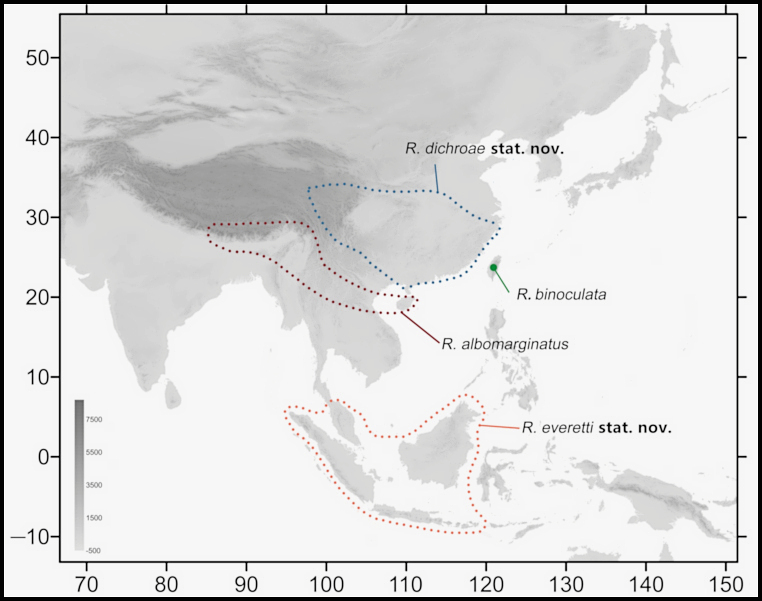
Map: Distribution of species of the albomarginatus group of the genus Rhagastis. The blue dotted line indicates the range of R. dichroae, the red dotted line indicates the range of R. albomarginatus, the orange dotted line indicates the range of R. everetti, and the green circle indicates the range of R. binoculata (© Jiang, Wang, Xu, Kitching, Huang, Hu & Xiao, 2024).
 Return to Sphingidae of the Eastern Palaearctic species list
Return to Sphingidae of the Eastern Palaearctic species list